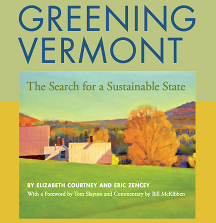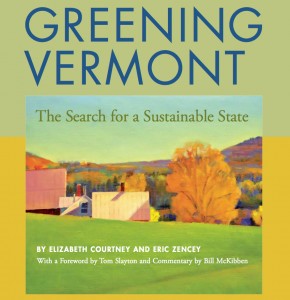
 Greening Vermont, The Search for a Sustainable State, by Elizabeth Courtney and Eric Zencey. Paperback. 173 pages. Published by Thistle Hill Publications, North Pomfret, Vermont, and the Vermont Natural Resources Council, Montpelier, Vermont. $35.00
Greening Vermont, The Search for a Sustainable State, by Elizabeth Courtney and Eric Zencey. Paperback. 173 pages. Published by Thistle Hill Publications, North Pomfret, Vermont, and the Vermont Natural Resources Council, Montpelier, Vermont. $35.00
Reviewed by Tena Starr
A book whose main characters are, arguably, Act 250 and I91 might not strike a potential reader as having much promise in the way of being riveting, but Greening Vermont is actually a highly readable book with much insight into what makes Vermont be Vermont. It’s the story of environmentalism in the Green Mountain State — its successes, its failures, its current goals, its conflicts, and its evolution in the face of shifting challenges.
It’s also, almost accidentally, a modern history of the state, evidence of just how thoroughly Vermont’s character has become entwined with, and often defined by, how its farms, forests and waterways are used and how its towns and cities look and function.
In order to understand environmentalism in Vermont, it’s necessary to go back 150 years to a boy named George Perkins Marsh, who grew up on a farm outside Woodstock and, through his father, began to grasp the relationship between man and nature. Among other things, he learned about natural watersheds and soil erosion, about their effects as well as their causes.
So says Tom Slayton, former editor of Vermont Life magazine, and author of the forward to Greening Vermont. Mr. Slayton says that Mr. Marsh went on to be the first to argue that human actions could seriously damage natural systems, and in 1864 he wrote Man and Nature, a tome that warned about the havoc humans could wreak on nature.
Jump ahead to 1958. It was a chilly Saturday morning in November and a few hundred citizens and officials gathered near Guilford on the Vermont-Massachusetts border. In the book, grainy black and white photos show a collection of people in overcoats, men in fedoras, waiting to cut the white ribbon stretched across the new, and at the time remarkable, highway. It’s a scene from another era, in so many ways.
“They were there to mark an important moment in the state’s environmental history — though it’s doubtful that any of the participants would have described what they were doing in those terms,” Ms. Courtney and Mr. Zencey write. “They had gathered to listen to speeches, witness a bit of ceremony, and then climb in their cars to take an inaugural drive on Vermont’s first stretch of Interstate highway.”
It took just minutes to travel that first small stretch of Interstate. However, Ms. Courtney and Mr. Zencey suggest the new road was the catalyst that led to rapid change in Vermont, and the need for environmental regulations to protect what isolated Vermonters had come to treasure, if also take for granted.
“The opening of those first few miles of modern roadway signaled the opening, also, of an era of rapid and far-reaching change for the state of Vermont, which had been until then a lightly populated, rural mountain fastness,” the authors say. “Many of the hallmarks of modern life — television, telephones, even electricity — were not yet fully present in the state. The engines of twentieth-century progress had largely passed the state by. It was too remote, its population too sparse, its towns and villages too small to draw much attention. With the arrival of the Interstate that was about to change very quickly, for the world that held Vermont in a remote and distant corner had suddenly become much smaller. As one state official put it years later, the highway ‘took us out of the sticks and put us within a day’s drive of eight million people.”
In 1960 Vermont’s population was 389,881 with nearly 77 percent born in the state. There were 9,400 farms and 258,000 cows. About 2,624,370 acres were being farmed. That was the first year that people outnumbered cows in Vermont.
Twenty years later, by 1980, the population was 511,456, with 64 percent born in Vermont. The number of farms had dropped by nearly half, to 5,890 with 1,537,751 acres in farming. There were 186,000 cows.
When that first stretch of Interstate was built, “growth and expansion — the easily foreseeable result of the Interstate — were widely embraced,” Ms. Courtney and Mr. Zencey write. “If change meant jobs, a path out of rural poverty, and lives like those whose images had begun to flicker in (some) Vermont homes through the wonder of television, then change was good. What wasn’t so easily foreseen was how thoroughly those changes would shape the state, testing its ability to preserve its landscape, its communities, and its character.”
Not everyone welcomed change then, as not everyone does today. Former Associated Press reporter Chris Graff has told the story of an Ascutney farmer who refused to leave his land to make way for the Interstate.
“Eventually a sheriff arrived with a court order and a cohort of deputies, who set to work dispossessing the old man from the family farm,” Ms. Courtney and Mr. Zencey write, recounting the story. “They moved tools and harnesses from the outbuildings, working until sunset, intending to return the next morning to finish. They never got the chance. That night Tenney’s house and buildings burned to the ground, with him inside.”
Romaine Tenney had said, “I was born here and I’ll die here.” He was a man of his word.
And then came skiing.
With the introduction of rope tows and lifts in the 1930s, skiing was no longer limited to the hardiest of mountain climbers. Once skiers had a ride uphill, the sport’s popularity was immense, and the owners of ski areas ceased to be content with what existed. They used heavy equipment and dynamite to create new trails and reshape mountain slopes to make them more attractive to devotees of this newly mainstream sport.
Opponents of industrial wind on Vermont’s ridgelines will relate to this scenario. Blasting mountaintops is not so much new as a revisitation of what happened 60 years ago on an even larger scale. Then, as now, there was debate — roughly framed in the terms of conservationist versus preservationist.
It’s a conversation that would be familiar to anyone who has participated — either pro or con — in the controversy over commercial wind power. At the time, as today, the mountaintop debate split environmentalists, with conservationists operating under the belief that using resources for the greatest good for the greatest number over the greatest period of time was the wisest use. That view was at odds with “preservationism,” which held that nature should simply be left to its own devices for all to enjoy.
Ski areas created jobs but also pulled in a flood of newcomers, increasing property values, advanced commercialism, and burdened municipal services. And at the time, there was no means to deal with the influx, with the billboards, the development, the seasonal homeowners — and the cultural, as well as environmental, changes that resulted. Vermont went from a “handshake” culture to one that was forced to rely more on law and formally structured exchanges, the book asserts.
“The social cost of that change is difficult to calculate, but a direct measure of its scale can be made in dollars,” the authors write. “In the late 1940s, skiers spent about five million annually in the state. By the early 1960s, that figure had risen to well over thirty million, a sixfold increase in a decade and a half.”
Thomas Watson Jr., an avid skier himself, decided in 1957 to locate IBM in Chittenden County to be near his beloved ski areas. IBM remains the state’s biggest employer.
Vermont’s organized environmental movement was likely established at Goddard College in Plainfield in 1963 where a two-day conference called Natural Resources in Transition was held and the Vermont Natural Resources Council (VNRC) was formed, an all volunteer organization at the time with the goal of shaping public policy through education and “to promote wise use and preservation of natural resources to the benefit of Vermont citizens….”
It was not VNRC, however, that waged war against Vermont’s billboards. It was a character named Ted Riehle. This book is populated by many characters Vermonters will admire for their courage, their quirkiness, their bullheadedness, or their idealism.
Mr. Riehle is one of them. “A lifelong Republican, a fan of both Barry Goldwater and the Grateful Dead, he was a well-connected politico who much preferred the solitude he got as the owner-operator-designer of an off-the-grid sheep farm on an island in Lake Champlain,” the book says. His son called him “Jimmy Stewart meets John Wayne.”
In 1968, Mr. Riehle somehow convinced his fellow Republicans to support a total ban on roadside commercial advertising. He also managed to persuade business owners that the ban would be in their long-term best interests — that individual self-interest would bring about loss for all.
That ban is one of Vermont’s hallmarks, as is Act 250, the environmental law that set out to regulate how the state would be developed — not haphazardly, not simply for short-term profit, but with a vision in mind of what Vermont would like to be and look like.
Act 250 has been a heavy lifter toward that end, but nearly 40 years later, even it remains subject to criticism and steady calls for alteration.
It’s 2013 now, and many battles have been fought, Vermont has, for the most part, resisted rampant sprawl. But challenges continue, in many forms.
“Vermont is not now a sustainable state, but in the effort to achieve that goal, it has a head start,” the authors of this book write. “How this came to be is the story we have aimed to tell in this book.”
It’s a story they’ve told well, a bit idealistically perhaps, but it’s one that acknowledges many factions in the great and ongoing debate about what Vermont is and will be.
“And what exactly is a sustainable state?” the authors write. “As with any longed-for object, distance and anticipation shape our expectation, making the destination seem a completely marvelous place. We’ll recognize the sustainable state as a place where economic and environmental interests are identical, because we’ve shaped the economy to the limits that the planet gives to us and learned our hard lessons about what is and isn’t possible.”
The old challenges are not conquered, and new ones have arisen — climate change, for instance, and commercial wind. There is no final solution, only a continuing and ever shifting challenge.
This book tells the story of how we got to where we are today, where we’d like to be tomorrow, and offers a bit of advice on how to get there. Along the way, it recounts conversations with some of the people who have been instrumental in many of those endeavors, tells a remarkable history, and provides some vision for the future.
Elizabeth Courtney served on Vermont’s Environmental Board for a decade, and she was executive director of the Vermont Natural Resources Council for 14 years. She was a Loeb Fellow at Harvard University and is now an environmental consultant.
Eric Zencey is a Fellow at the Gund Institute for Ecological Economics at the University of Vermont and has held fellowships from the Guggenheim and Rockefeller-Bellagio Foundations. He writes regularly for the Daly News, a publication of the Center for the Advancement of the steady State Economy. He is the author of three previous books.
contact Tena Starr at [email protected]







